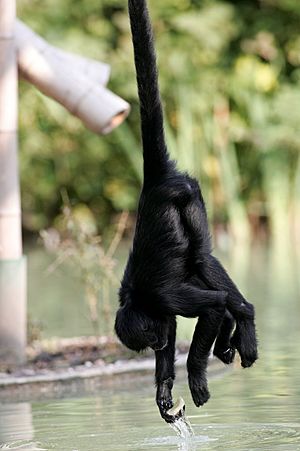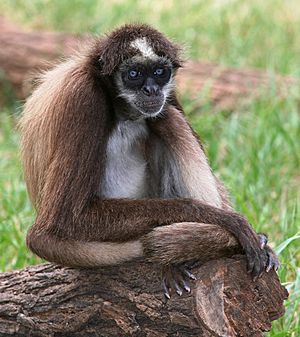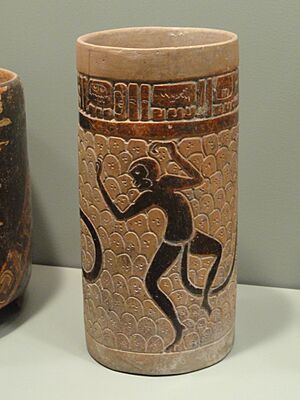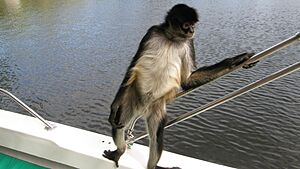Spider monkey facts for kids
Quick facts for kids Spider monkey |
|
|---|---|
 |
|
| A black-headed spider monkey (Ateles fusciceps) using its prehensile tail. | |
| Scientific classification | |
| Kingdom: | |
| Phylum: | |
| Class: | |
| Order: | |
| Suborder: | |
| Family: |
Atelidae
|
| Genus: |
Ateles E. Geoffroy, 1806
|
Spider monkeys are a type of New World monkey found in the rainforests of southern Mexico and northern South America. These amazing animals, belonging to the genus Ateles, are perfectly built for life high up in the trees. They are very quick and rarely come down to the ground. They move fast through the forest by swinging and jumping from branch to branch.
Spider monkeys live in groups, sometimes called "bands," of 10 to 40 monkeys. Each group has its own special area, and they usually don't go into another group's territory. A female spider monkey usually has one baby each year. These monkeys can live for a long time, often between 20 to 27 years, or even longer!
Contents
What Do Spider Monkeys Eat?
Spider monkeys mainly eat fruits, nuts, and leaves. They also sometimes eat small eggs.
The lead female in a group is often in charge of finding food for everyone. If there isn't enough of their usual food, they might eat tree bark, honey, or even insects.
How Do Spider Monkeys Look?
Spider monkeys are known for being incredibly fast. They have long, thin fingers with very little hair. What makes them special is their tail! It's much longer than their body and they use it more than their hands.
Their tails are called "prehensile," which means they can grasp and pick things up with them. They can even swing from their tails! A spider monkey's tail can be up to 89 centimeters (35 inches) long. It's very flexible, with hairless tips that have grooves, much like human fingerprints. This special tail acts like a fifth hand, helping them live their lives entirely in the trees. Because of their long, thin limbs, they are sometimes called "spider" monkeys. They are not very good at moving around on the ground.
Spider Monkey Behavior

Spider monkeys live in loose groups, usually with 15 to 25 monkeys, but sometimes up to 30 or 40. During the day, these larger groups often split into smaller subgroups. How big these subgroups are, and how much they stay away from each other, depends on how much food is available and how much danger there is from predators. An average subgroup has about 2 to 8 monkeys, but can sometimes have up to 17.
Spider monkeys use different body positions and movements to show what they are thinking or what they have seen. If a spider monkey sees a human coming, it might bark loudly, like a dog. If someone gets too close, the monkey will climb to the end of a branch and shake it hard to try and scare the person away. They shake branches with their feet, hands, or both, often while hanging by their tail. They might also scratch themselves. Monkeys sitting down might sway and make noise. Male monkeys, and sometimes adult females, will growl if a human gets too close. If the person keeps coming, the monkeys might even break off tree branches, some weighing up to 4 kg (9 pounds), and drop them towards the intruder.
Spider monkeys are diurnal, meaning they are active during the day. They sleep at night in carefully chosen trees. It's thought that a lead female guides the group, planning the best routes to find food each day. Grooming each other is not as important for their social interactions, possibly because they don't have thumbs like some other monkeys.
Spider monkeys have been seen avoiding the very top branches of trees when they move around. One scientist thought this might be because the thin branches at the top can't support their weight very well.
A spider monkey's brain weighs about 107 grams (3.8 ounces). This is twice the size of a howler monkey's brain, even if the howler monkey is the same body size. Scientists think this is because spider monkeys have a complex social life and eat many different kinds of ripe fruits from over 150 plant species. This means they need to remember when and where to find fruit. They also grow up slowly: they can live for 20 to 27 years or more, and females have babies only every 17 to 45 months. The oldest known spider monkey in captivity, named Gummy, lived to be 61 years old, which is about twice as long as most spider monkeys.
Reproduction and Life Cycle
The time a baby spider monkey spends inside its mother (called gestation) is about 226 to 232 days. Each female usually has only one baby every three to four years.
For the first six to ten months, baby spider monkeys depend completely on their mothers. Male spider monkeys do not help raise the babies.
A mother carries her baby on her belly for the first month. After that, she carries it on her lower back. The baby wraps its tail around its mother's tail and holds tightly to her middle. Mothers are very protective and caring. They have been seen grabbing their young and putting them on their backs to keep them safe and help them move between trees. They also help older, more independent young ones cross gaps by pulling branches closer together. Mothers also groom their young.
Spider Monkeys in Culture

Spider monkeys appear in many parts of Mesoamerican cultures. In the Aztec 260-day calendar, the 11th day is named "Spider Monkey" (Ozomatli in Nahua). In the similar Maya calendar, the Howler Monkey (Batz) is used instead of the Spider Monkey. Today, in Maya religious celebrations, people dressed as spider monkeys act like funny, mischievous clowns. In ancient Maya art, spider monkeys are often seen, sometimes carrying cacao pods.
A cartoon show called Captain Simian & the Space Monkeys features a spider monkey named Spydor, who is the smallest member of the crew.
Images for kids
-
Spider monkey skeleton on display at The Museum of Osteology, Oklahoma City, Oklahoma
See also
 In Spanish: Monos araña para niños
In Spanish: Monos araña para niños




